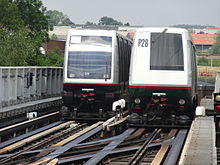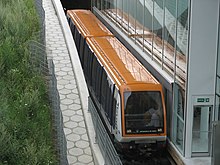Véhicule Automatique Léger


Véhicule Automatique Léger (lit. 'automatic light vehicle') or VAL is a type of driverless (automated),
A total of 11 lines in 8 systems based on the VAL technology are currently in operation worldwide. The current version of the VAL product is marketed as NeoVal (with a distinction between AirVal for airport environments and CityVal for more conventional transit environments).
The name is a
Technology
Original VAL

The VAL system uses a fully automated elevated
The vehicles are lightweight 2-car sets (VAL 206 or VAL 208) with 124 total capacity, or twin sets (VAL 256) with 80 seated and 160 standing capacity. All axles on these vehicles are motored with 150 kW (201 hp) electrical motors. The system detects the location of trains on the guideway by the use of ultrasonic sensors.[3] VAL uses fixed-block signalling.
VAL can cope with unanticipated demand by inserting additional trains into the network as required by remote command from the control center. The control center computer system automatically speeds up or slows down trains in order to maintain a timetable. The VAL system can handle headways as small as 60 seconds, and the Lille VAL system rapidly proved itself with a 99.8% availability.[4]
In contrast to another early driverless metro system, the
In addition to the trains being driverless, the station platforms are unstaffed in normal operation. In the original
NeoVal

In 2006 the NeoVal project, successor of the VAL, was announced. It features
The NeoVal is offered in two versions:
- the CityVal version designed for conventional transit environments (car width 2.65 m (8 ft 8 in)) with the first implementation on Line B of the Rennes Metro;
- the AirVal version designed for airport environments (car width 2.80 m (9 ft 2 in)) with the first implementation on the Suvarnabhumi Airport Automated People Mover at Suvarnabhumi Airport, Thailand.
VAL systems
Active systems
As of July 2021[update] there are a total of 12 lines in 8 systems operating with VAL technology:


- Lille Metro (two lines), since 1983, VAL 206 and VAL 208 cars
- Paris Orlyval, since 1991, VAL 206 cars
- Toulouse Metro (two lines), since 1993, VAL 206 and VAL 208 cars
- Taipei Metro Wenhu (Brown) line, since 1996, larger VAL 256 cars using the MAGGALY technology from Lyon Metro Line D and Bombardier signaling
- Rennes Metro (two lines), since 2002, VAL 208 and CityVal cars
- Turin Metro, since 2006, VAL 208 cars
- Paris CDGVAL (two lines), since 2007, VAL 208 cars
- Uijeongbu U Line, since 2012, VAL 208 cars with air conditioning, locally designated the U100
- Bangkok Suvarnabhumi Airport, since 2023 - 6 2-car AirVal trains[7]
Future systems
- Frankfurt Airport SkyLine (rehabilitation of existing people mover system) - 24 2-car AirVal trains[8]
Defunct systems
- Airport Transit System at Chicago's O'Hare International Airport (opened in 1993 and replaced by a Bombardier system in 2019 and reopened in 2021)
- Jacksonville, Florida, had a VAL line inaugurated in 1989; it was shut down in December 1996 and replaced by a monorail, the Jacksonville Skyway. The rolling stock was sold to O'Hare.
Medium-Capacity Transport System
When VAL was introduced to
See also
Competing systems:
- Bombardier Innovia APM
- Crystal Mover from Mitsubishi Heavy Industries
References
- ^ Bushell, Chris, ed. Jane's Urban Transport Systems 1995-96. Surrey, United Kingdom: Jane's Information Group; 1995. p178, 472
- ^ Bushell, Chris, ed. Jane's Urban Transport Systems 1995-96. Surrey, United Kingdom: Jane's Information Group; 1995. p472-3
- ^ Bushell, Chris, ed. Jane's Urban Transport Systems 1995-96. Surrey, United Kingdom: Jane's Information Group; 1995. p472-3
- ^ Bushell, Chris, ed. Jane's Urban Transport Systems 1995-96. Surrey, United Kingdom: Jane's Information Group; 1995. p472-3
- ^ Bushell, Chris, ed. Jane's Urban Transport Systems 1995-96. Surrey, United Kingdom: Jane's Information Group; 1995. p178
- ^ euromedtransport.org[permanent dead link]
- ^ "Siemens builds fully automated people mover at Suvarnabhumi airport". 17 July 2020. Retrieved 27 November 2020.
- ^ "Siemens delivers fully automated people mover for the Frankfurt airport". 3 April 2018. Retrieved 27 November 2020.
External links
- Presentation of the NeoVal system on the official Siemens website
- "Documentation technique du VAL 206 [dont le VAL 208 en est l'évolution]" (PDF). traction-electrique.ch (in French). Retrieved 7 February 2023.
